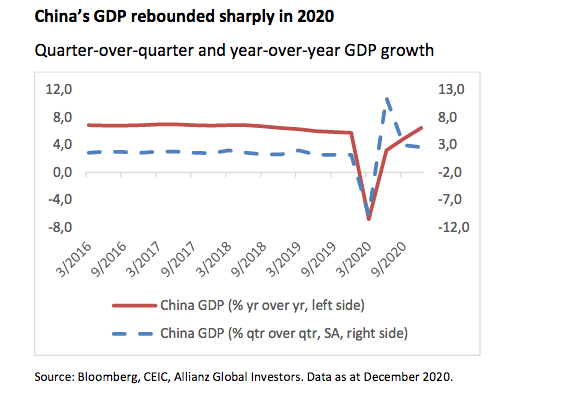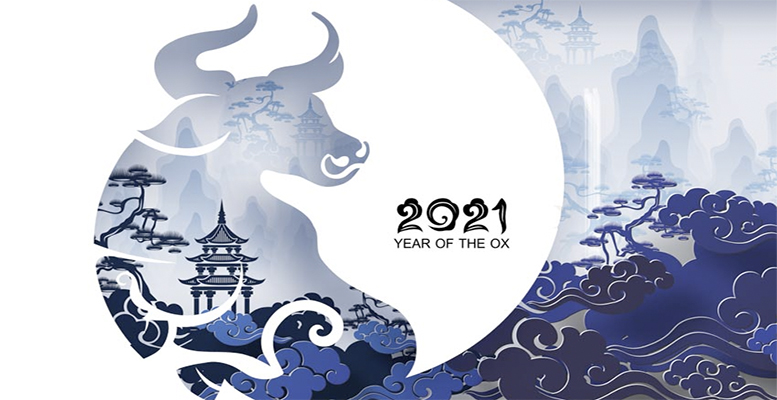AllianzGI | This lunar new year, China has much to celebrate – including resilient economic growth, widespread success at suppressing Covid-19 and a steady transformation into an advanced economy. That’s why the ox is a suitable symbol for a country that continues to do the hard work needed to maintain its trajectory.
China was the only major world economy to grow its GDP over the last year. We expect it will continue its strong recovery from the coronavirus crisis, although perhaps at a slightly slower pace. Year-on-year GDP growth numbers look strong because of the weak comparisons with 2020 at the height of the pandemic (see chart).

Still, China seems set to continue its upward climb. The service sector should do well, assuming the government can suppress renewed outbreaks of the coronavirus. The manufacturing sector also appears likely to keep growing, helped by public investment projects (which may slow slightly in 2021 compared with 2020) and a gradual recovery of global demand as Covid-19 passes. And China is nurturing its own high-tech industries –particularly robotics, aviation and other advanced-manufacturing areas that are at the heart of its long-term economic vision.
Over the course of 2021, this economic strength may enable China to do something that other major economies haven’t been able to: ease back on the massive stimulus that the government is pumping into the economy. This could take the form of slightly lower government spending – perhaps resulting in less investment in physical infrastructure – though we expect to see continued support for innovative technologies, small- and medium-size enterprises and the “green economy”. The People’s Bank of China is also slowing down credit growth by reducing the amount of new loans provided by financial institutions. However, we don’t anticipate these fiscal or monetary policy changes to be sudden or drastic.
What does this mean for investors? Financial markets tend not to like it when stimulus is withdrawn – or, in this case, slightly reduced – so this could make China’s short-term investment outlook a bit bumpier. But over the long term, China’s economic story is compelling, which we believe makes for an attractive long-term investment case as well. As such, we think investors should continue to think of China as an asset class in its own right – one that may warrant a dedicated, standalone allocation.
As investors look ahead towards what the Year of the Ox will bring, what could cause our economic outlook to become less bullish – or even more? Here are some of the more significant variables for investors to watch. Four key investment questions for the coming year.
1.Will China keep the coronavirus at bay? Covid-19 is the main risk for economic growth globally – and China is no exception. But China and Asia overall seem to be in a better position than their Western counterparts, given that the United States, the European Union and other major economies are still struggling to bring the coronavirus under control. If China’s economy keeps up its strong recovery, China’s equity and bond markets may look increasingly attractive.
2. Will China repair relationships with existing trading partners – and strengthen new ones? China’s troubled relationship with the US has been a major geopolitical theme in recent years. US President Joe Biden may help reduce tensions, but some issues will undoubtedly remain. This is one reason why China has been steadily becoming more self-sufficient by strengthening its supply chains, building up its own advanced-manufacturing capabilities and forming new alliances.
For example, the new Regional Comprehensive Economic Partnership (RCEP) creates an economic bloc of Asia-Pacific nations that covers a third of the world’s population. The RCEP deal will apply to almost 30% of global trade and GDP – more than the EU’s trading bloc or the US-Mexico-Canada agreement. The EU andC hina also recently announced their Comprehensive Investment Agreement CAI) after seven years of negotiations. This should provide the EU with access to important new commercial opportunities in the manufacturing, automotive and financial services sectors, among others. For China, the CAI is a strategic breakthrough, helping it form new international partnerships amid the rise of protectionism and anti-China sentiment.
3. Will China keep up its successful economic transformation – or will it overreach? China continues to make progress in developing innovative technologies that help the country compete in higher value-adding, advanced-manufacturing sectors such as robotics and aviation. Recently, China officially launched its “Dual Circulation Strategy”, which involves substituting imported goods (such as semiconductors) for domestic ones while expanding domestic demand. The goal is to further advance China’s per-capita GDP so the country can more quickly complete its transformation to an advanced economy.
These policies have been well-received by the financial markets overall, but others haven’t been. China’s regulators recently clamped down on some of the country’s best-known corporations, accusing them of monopolistic and anti-consumer behaviour. However, we don’t believe Beijing will take this too far for fear of putting Chinese companies at a competitive disadvantage.
4. Will China continue emphasising sustainability?
Slowly but surely, China is devoting more attention to the issues that are critical to the sustainability of its economy.
• China has made significant investment in renewable energy, electric vehicles, hydrogen technology and other “clean tech” areas. In 2020 alone, China added 120 gigawatts of electricity capacity– more than the entire capacity of the UK – through wind and solar projects that were completed or launched that year.
• Corporations in China have come a long way in instilling greater confidence in their governance and reporting. More companies are issuing environmental, social and governance (ESG) reports: 85% in 2019, up from only 55% five years agoiii. China is also implementing new reporting requirements that are arguably stricter than those in the US.
At the same time, China must do more to improve transparency so investors can understand more about how companies and policymakers are approaching important ESG issues. Until then, it’s vital for investors to find partners who can provide proprietary research into what’s really happening behind the scenes.





